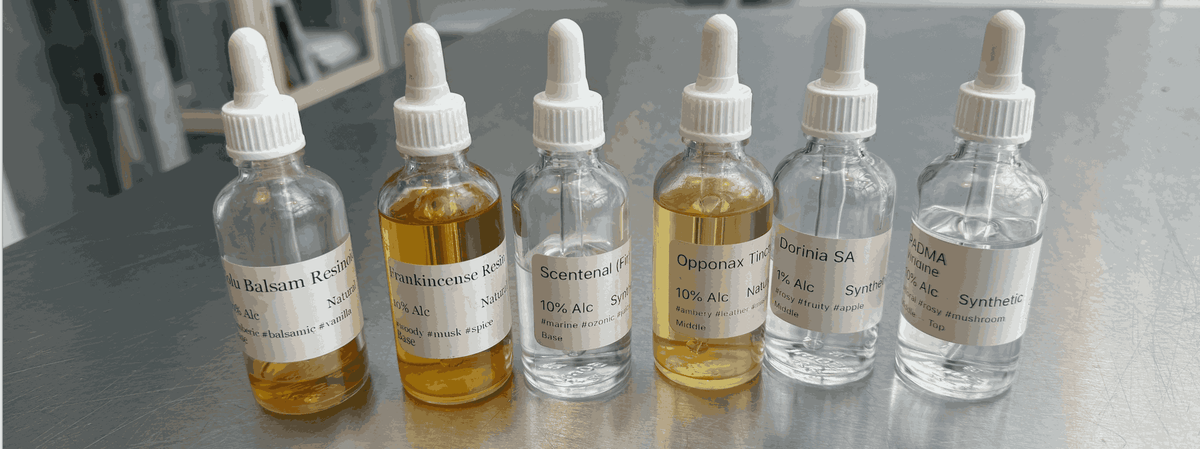
Natural vs. synthetic: The truth about perfume ingredients
|
Time to read 4 min
|
Time to read 4 min
A common question in the world of perfumery is: What’s the difference between natural and synthetic scents, and which is better?
It’s a fair question. In a world increasingly driven by “clean” claims and greenwashing gloss, the word “natural” has taken on an almost mythical, virtuous weight. We hear it all the time: “Nature does things well.” And yes, it does. But does it do everything better? Especially when it comes to perfumery , an art form that’s just as much about longevity and structure as it is about sensual pleasure?
At mmoire, we believe in both. We use natural ingredients where they make sense and admire their raw beauty. But our creations tend synthetic, and that’s no accident. Let’s unpack why.
Natural ingredients in perfumery are sourced from the earth: petals, peels, woods, resins. The methods are age-old, steam distillation, cold pressing, solvent extraction, and the results are often poetic. There’s something deeply romantic about rose oil distilled from thousands of blooms, or bergamot extracted from sun-warmed rind.
But behind the romance is a certain chaos. These extracts can contain hundreds of aromatic compounds, an orchestra of molecules that vary depending on soil, weather, and harvest. This means your beloved neroli from Tunisia might smell slightly different each year, like wine vintages or olive oil batches. Beautiful? Yes. Consistent? Not exactly.
And then there’s the environmental price . To obtain one kilo of rose oil, over three tons of petals are needed. As noted by the artisans at Les Bains Guerbois, the immense demand for such natural materials can lead to large-scale monoculture farming, land depletion, and biodiversity loss. In some cases, think Mysore sandalwood or guaiac wood, we're talking about ingredients sourced from endangered species or fragile ecosystems.
Natural doesn’t always mean innocent.
This is where synthetics enter, not as villains, but as precision tools in a perfumer’s kit. These molecules are lab-made: some designed to replicate natural fragrances that can’t be extracted (like the clean, dewy sparkle of lily of the valley), others dreamt up from scratch to offer something entirely new.
They're the reason your fragrance still clings to your collar two days later. Molecules like Ambroxan or Iso E Super have become modern perfumery icons not because they mimic nature, but because they enhance it, adding texture, pheromones , diffusion, and longevity where naturals sometimes fall short.
Karen Gilbert, a fragrance industry insider turned educator, makes a compelling point: synthetics allow perfumers to work more sustainability and with far greater control. They’re reliable, batch-stable, and don't require 20 acres of petals or rare tropical woods to produce. And with the rise of green chemistry and biotechnology, many synthetics fragrance today are derived from renewable carbon sources or fermented with yeast instead of petroleum.
Far from being “fake,” they’re simply engineered elegance.
There’s a deep irony in the idea that natural ingredients are automatically better for the planet. While they come from the earth, they also consume it, often in vast amounts. Sourcing naturals at scale can involve deforestation, over-harvesting, and a troubling carbon footprint tied to farming and extraction.
Meanwhile, certain synthetic ingredients can offer a significantly lighter environmental load. When responsibly produced, fragrance ingredients help protect endangered species, reduce land usage, and sidestep ecological overexploitation altogether. It’s not a perfect system, petrochemical-based synthetics do have their baggage, but when viewed through the lens of scale and ethics, they’re often the more responsible choice.
As Les Bains Guerbois put it, the future of perfumery may well depend on our ability to reconcile the romanticism of naturals with the realism of science.
That said, which one wins? The truth is: neither.
At mmoire, we see perfume as a balance , between raw sensuality and refined intention, between nostalgia and innovation. Natural ingredients bring soul and nuance; synthetic ones bring stability, longevity , and freedom to invent entirely new olfactive worlds in our fragrances.
We use both, with care and purpose. Because creating a signature scent isn’t about choosing sides. It’s about telling a story that lasts.
Curious how this philosophy smells?
Explore our collection to experience the best of both worlds, where petals meet molecules, and nature meets memory.
For more detailed information on perfume notes and the fragrance pyramid, check out Perfume.com's guide to fragrance notes or Fragrantica's encyclopedia of perfumes.
Another essential aspect of perfume is its classification into fragrance families. Fragrance families are groups of perfumes that share similar olfactory characteristics, such as floral, fruity, woody, or oriental. Understanding fragrance families can help you narrow down your choices and discover perfumes that align with your preferences.
If you like the family that comes across as woody or aromatic, try our Sur Arize fragrance with our sample set.
Perfume is a fascinating blend of art and science, and understanding its basics can enhance your appreciation for this timeless luxury. By exploring the perfume pyramid, fragrance families, and other fundamental concepts, you can embark on a journey of sensory discovery and find the perfect scent to complement your style and personality.
Can’t get enough of the perfume industry? We recently wrote a blog about ‘Pheromone Perfumes’ and how you can discover your Signature scent: ‘A guide to finding your perfect perfume’



